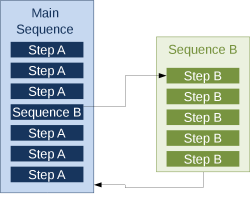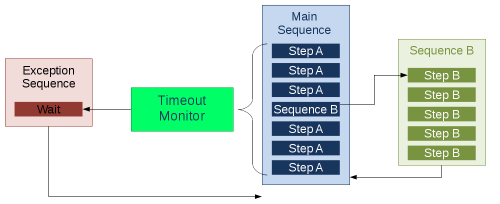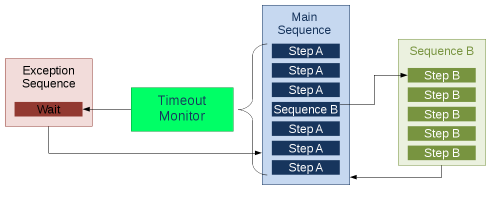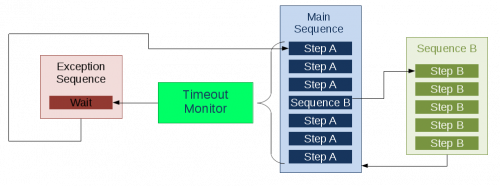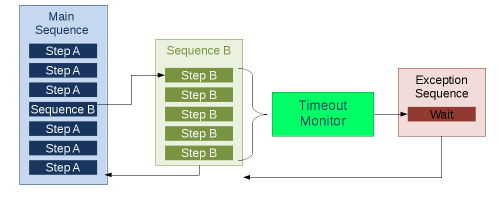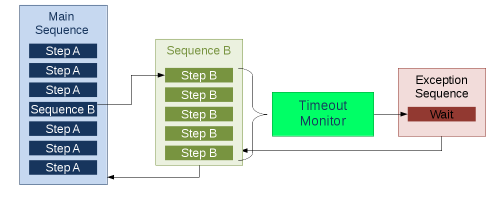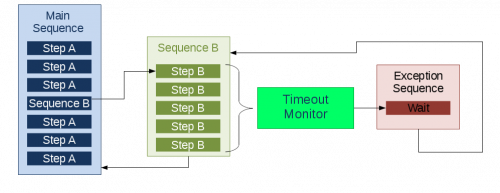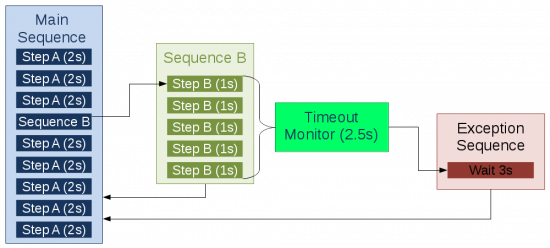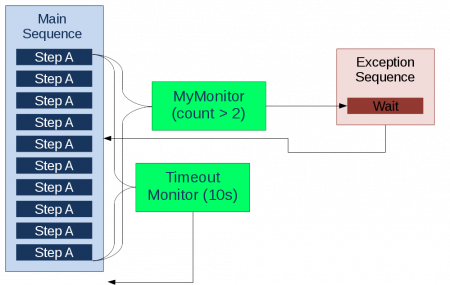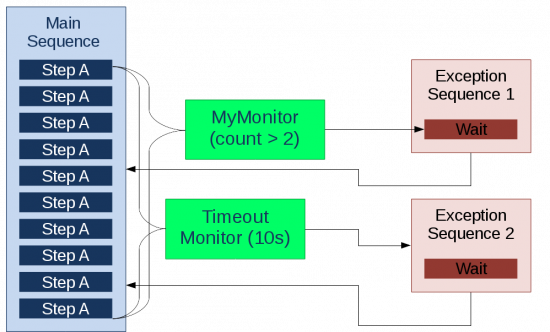This is an old revision of the document!
Example with Nonblocking Sequence
The following example all have a main sequence which calls a few steps and a another sequence. This second sequence is a nonblocking sequence. That means that the main sequence runs in parallel to the second sequence. A timeout monitor either supervises the main sequence or the second sequence.
Main Sequence Calls Nonblocking Sequence
In the EEROS library you will find a directory with examples. Open a shell in the build directory of your EEROS library and run
$ ./examples/sequencer/sequencerTest30
The main sequences starts with three Step A after which the Sequence B is called. Sequence B is nonblocking, that means both sequences run in parallel. The main sequence will do three more Step A before finishing.
Please note the method action of the main sequence.
int action() { for (int i = 0; i < 3; i++) { stepA(1); } seqS(); for (int i = 0; i < 3; i++) { stepA(1); } seqS.wait(); return 0; }
At the end of the method you have to wait for the subsequence as it runs in its own thread.
Main Sequence Has Timeout Monitor
A next example demonstrates what happens if the main sequence is interrupted by a monitor while a subsequence is called. Run
$ examples/sequencer/sequencerTest31
The main sequence does three steps and starts the second sequence. The timeout monitor of the main sequence fires while the second sequence still runs. The monitor causes an exception sequence to run. After that the main sequence terminates immediately as the timeout behavior is set to abort. The subsequence continues running in its own thread.
Main Sequence Has Timeout Monitor With Resume
A next example demonstrates what happens if the main sequence is interrupted by a monitor while a subsequence is called. Run
$ examples/sequencer/sequencerTest32
The main sequence does three steps and starts the second sequence. The timeout monitor of the main sequence fires while the second sequence still runs. The monitor causes an exception sequence to run. After that the main sequence continues where it was interrupted as the timeout behavior is set to resume. The subsequence continues running in its own thread.
Main Sequence Has Timeout Monitor With Restart
A next example demonstrates what happens if the main sequence is interrupted by a monitor while a subsequence is called. Run
$ examples/sequencer/sequencerTest33
The main sequence does three steps and starts the second sequence. The timeout monitor of the main sequence fires while the second sequence still runs. The monitor causes an exception sequence to run. After that the main sequence starts again as the timeout behavior is set to restart. The subsequence continues running in its own thread. The main sequence will again call the subsequence and the same procedure will follow. This would continue endlessly if the behavior would not change to abort after three runs.
Subsequence Has Timeout Monitor
A next example demonstrates what happens if the subsequence is interrupted by a monitor while being called from the main sequence. Run
$ examples/sequencer/sequencerTest34
The main sequence does three steps and starts the second sequence. The timeout monitor of the subsequence fires. The monitor causes an exception sequence to run. After that the subsequence terminates immediately as the timeout behavior is set to abort. The main sequence continues running in its own thread.
Subsequence Has Timeout Monitor With Resume
A next example demonstrates what happens if the subsequence is interrupted by a monitor while being called from the main sequence. Run
$ examples/sequencer/sequencerTest35
The main sequence does three steps and starts the second sequence. The timeout monitor of the subsequence fires. The monitor causes an exception sequence to run. After that the subsequence continues from where it was interrupted as the timeout behavior is set to resume. The main sequence continues running in its own thread.
Subsequence Has Timeout Monitor With Restart
A next example demonstrates what happens if the subsequence is interrupted by a monitor while being called from the main sequence. Run
$ examples/sequencer/sequencerTest36
The main sequence does three steps and starts the second sequence. The timeout monitor of the subsequence fires. The monitor causes an exception sequence to run. After that the subsequence restarts as the timeout behavior is set to restart. The main sequence continues running in its own thread. The subsequence would restart again and again while the main sequence would have to wait for it. After three restarts the timeout behavior is set to abort and subsequence and main sequence terminate.
Example with several Monitors
it will run in parallel. Step A and Step B will be called in parallel, though their waiting time is different. Sequence B has its timeout condition set to 2.5s. This causes its associated timeout monitor to interrupt the sequence and jump to an exception sequence. In the meantime the main sequence continues unhindered. After the exception sequence Sequence B is aborted, because its monitor behavior is set to abort. The program stops after the main sequences has finished running its steps.
The main sequences starts with three Step A after which the Sequence B is called. Sequence B is nonblocking, that means, it will run in parallel. Step A and Step B will be called in parallel, though their waiting time is different. Sequence B has its timeout condition set to 2.5s. This causes its associated timeout monitor to interrupt the sequence and jump to an exception sequence. In the meantime the main sequence continues unhindered. After the exception sequence Sequence B is aborted, because its monitor behavior is set to abort. The program stops after the main sequences has finished running its steps.
Sequence with two Monitors
In the EEROS library you will find a directory with examples. Open a shell in the build directory of your EEROS library and run examples/sequencer/SequencerTest4.
This example shows a sequence with two associated monitors. The Main Sequence tries to run several steps called Step A. After each step counter is incremented. A monitor checks for this count to reach a given level (MyMonitor). As soon as this happens an exception sequence is started. After termination of the exception sequence the original sequence resumes because the monitor property is set to resume. The Main Sequence continues and is soon interrupted by its timeout monitor because its timeout limit has expired. The timeout monitor has no exception sequence assigned to it and immediately aborts the Main Sequence and with it the application because its monitor property is set to abort.
Altering the Monitor Behavior
Change the behavior of My Monitor to restart, recompile, and observe what happens. After the exception sequence the Main Sequence restarts. This causes the counter to start with 0 and the timeout will be reset as well. Hence, the timeout monitor will never fire.
If you change the behavior of the timeout monitor to restart, things get more complicated. MyMonitor will fire, the exception sequence will run, the Main Sequence will resume, and the timeout monitor will fire. This monitor has no exception sequence but will simply restart the whole procedure.
Monitor Checking two Sequences
A next example demonstrates what happens if the same monitor checks two sequences. It can be found in examples/sequencer/SequencerTest5.
The Main Sequence and Sequence B have the same monitor. The Main Sequence tries to run several steps called Step A. After each step a counter is incremented. A monitor checks for this count to reach a given level (MyMonitor). The same monitor also checks Sequence B, which runs in parallel. As soon as the monitor condition is met, both sequences will abort because the monitor property is set to abort.

